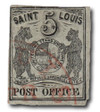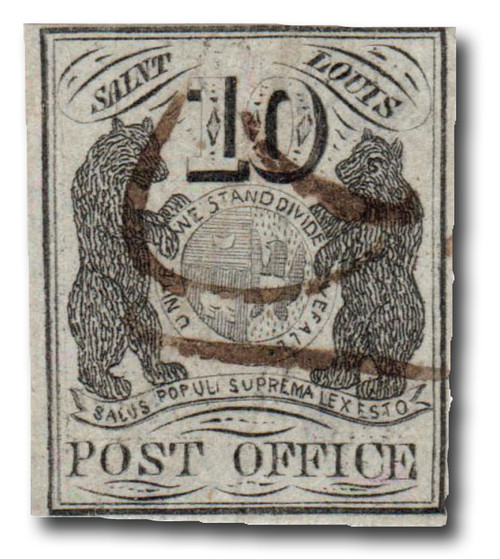
# 11X1 - 1845 5c Black, St. Louis Bear on Greenish Wove Paper
St. Louis Bears Postmaster Provisionals – Over 175 Years Old
Used on Mail Before the First Federal Postage Stamps of the United States!
Postmaster Provisionals are real artifacts of America’s postal history. They’ve survived the ravages of time (over 175 years) to remind us of that exciting history. The St. Louis Bears are among the most famous and sought-after Provisionals from the early days of America’s postal service. They’re history you hold in your hands.
What is a Postmaster Provisional?
The Act of 1845 established uniform postal rates in the United States. It wasn’t until two years later, on July 1st, 1847, that the issue of federal postage stamps was authorized. Until then, some postmasters issued their own stamps which are called “Postmaster Provisionals”. The first was issued in July, 1845, by the Postmaster of New York, Robert H. Morris. Postmasters in various other states followed suit, and the practice went on until the first two federal postage stamps were issued on July 1st, 1847. The Provisionals served as proof of the pre-payment of postage. Sometimes postmasters signed their name or initials on the stamps as well, which served as a cancellation.
The Story of the “St. Louis Bears”
St. Louis Postmaster John M. Wimer created the St. Louis Bears Provisionals to allow postal customers to pay ahead and avoid long lines and wait times at the post office. Instead, they could simply affix their stamp and drop their letter in a post box anytime, even after business hours.
The earliest documented use of any St. Louis Bears Provisional is November 13, 1845. The 5c variety shown here is from the 1845 printing. It was printed on greenish wove paper.
Most postally used St. Louis Bears stamps feature pen cancels, with hand stamp cancels being unusual, and even more highly sought-after.
The imperforate St. Louis Bears Postmaster Provisional stamps were issued in St. Louis, Missouri from November, 1845 to 1846. They were printed on wove paper ranging from greenish to grayish lilac to bluish in color. The exception is a later printing which was done on thin, hard paper called pelure.
In November 1845, Postmaster John M. Wimer had two stamps printed, 5c and 10c denominations. The designs on both pictured the Missouri coat of arms and great seal, each with its famous bear figures. (Missouri's great seal was designed by William G. Pettus who was said to have pictured bears in honor of “Missouri citizens’ rugged durability.”)
A single copper plate was engraved with six subjects (three vertical 5¢ stamps and three vertical 10¢ stamps) by J.M. Kershaw, proprietor of the Western Card and Seal Company of St. Louis. The 5¢ stamp covered the postage rate for letters under half ounce traveling less than 300 miles, while the 10¢ stamp covered the rate for letters traveling over 300 miles. Each additional half ounce required an added 5¢ or 10¢, depending on the distance.
Discover how to identify the types of St. Louis Bears Provisionals
The first printing of St. Louis Bears Postmaster Provisionals sold out and needed to be reprinted to keep up with demand. Postmaster Wimer decided it might be beneficial to include a 20¢ design this time, so the engraver (Kershaw) erased the “5” from the top two stamps in the left row of the plate and added a “20” to these positions instead.
The 5¢ denominations of the second printing soon sold out. Postmaster Wimer decided to remove the 20¢ denominations from the plate and reinsert the two 5¢ denominations since demand for the 20¢ stamps was lower than expected.
Below is a breakdown of each stamp type and how to tell the difference between them:
Stamp Types From Original State of the Plate – Printed on Greenish Paper
5¢ type I – the haunches of both bears virtually touch the frameline of the stamp
5¢ type II – the haunch of the left bear is well away from the frameline, the right bear is unchanged from type I
5¢ type III – the haunches of both bears are now visibly clear of the framelines
10¢ type I – there are three single curved lines (dashes) below "Post Office"
10¢ type II – there are three pairs of curved lines below "Post Office"
10¢ type III – three dots have been added between the pairs of curved lines, the top dash in the middle has been removed
Stamp Types From First Alteration of the Plate – Printed on Greenish OR Gray Lilac Paper
20¢ type I – same as the 5¢ type I from the original state of the plate
20¢ type II – same as the 5¢ type II from the original state of the plate. You'll also notice the top paw of the right bear was almost removed during the process of changing the "5" to "20."
5¢ type III – virtually unchanged from the original state of the plate. (This type printed on grayish lilac paper – Scott #11X4 – is the only St. Louis Bear stamp to have been printed from just one position of the plate, making it far rarer than many realize.)
10¢ types – unchanged from original state of the plate.
Stamp Types from Second Alteration of the Plate – Printed on Pelure Paper
5¢ type I – nearly the same as type I from the original state of the plate, but with the "5" noticeably lower.
5¢ type II – nearly the same as type II from the original state of the plate, however, the paw which had been damaged during the change to "20" was partly reinstated (without shading).
5¢ type III – nearly the same as type III from the original state of the plate, but with the dot in the ball of the "5" being much larger.
10¢ types – unchanged from original state of the plate.
St. Louis Bears Postmaster Provisionals – Over 175 Years Old
Used on Mail Before the First Federal Postage Stamps of the United States!
Postmaster Provisionals are real artifacts of America’s postal history. They’ve survived the ravages of time (over 175 years) to remind us of that exciting history. The St. Louis Bears are among the most famous and sought-after Provisionals from the early days of America’s postal service. They’re history you hold in your hands.
What is a Postmaster Provisional?
The Act of 1845 established uniform postal rates in the United States. It wasn’t until two years later, on July 1st, 1847, that the issue of federal postage stamps was authorized. Until then, some postmasters issued their own stamps which are called “Postmaster Provisionals”. The first was issued in July, 1845, by the Postmaster of New York, Robert H. Morris. Postmasters in various other states followed suit, and the practice went on until the first two federal postage stamps were issued on July 1st, 1847. The Provisionals served as proof of the pre-payment of postage. Sometimes postmasters signed their name or initials on the stamps as well, which served as a cancellation.
The Story of the “St. Louis Bears”
St. Louis Postmaster John M. Wimer created the St. Louis Bears Provisionals to allow postal customers to pay ahead and avoid long lines and wait times at the post office. Instead, they could simply affix their stamp and drop their letter in a post box anytime, even after business hours.
The earliest documented use of any St. Louis Bears Provisional is November 13, 1845. The 5c variety shown here is from the 1845 printing. It was printed on greenish wove paper.
Most postally used St. Louis Bears stamps feature pen cancels, with hand stamp cancels being unusual, and even more highly sought-after.
The imperforate St. Louis Bears Postmaster Provisional stamps were issued in St. Louis, Missouri from November, 1845 to 1846. They were printed on wove paper ranging from greenish to grayish lilac to bluish in color. The exception is a later printing which was done on thin, hard paper called pelure.
In November 1845, Postmaster John M. Wimer had two stamps printed, 5c and 10c denominations. The designs on both pictured the Missouri coat of arms and great seal, each with its famous bear figures. (Missouri's great seal was designed by William G. Pettus who was said to have pictured bears in honor of “Missouri citizens’ rugged durability.”)
A single copper plate was engraved with six subjects (three vertical 5¢ stamps and three vertical 10¢ stamps) by J.M. Kershaw, proprietor of the Western Card and Seal Company of St. Louis. The 5¢ stamp covered the postage rate for letters under half ounce traveling less than 300 miles, while the 10¢ stamp covered the rate for letters traveling over 300 miles. Each additional half ounce required an added 5¢ or 10¢, depending on the distance.
Discover how to identify the types of St. Louis Bears Provisionals
The first printing of St. Louis Bears Postmaster Provisionals sold out and needed to be reprinted to keep up with demand. Postmaster Wimer decided it might be beneficial to include a 20¢ design this time, so the engraver (Kershaw) erased the “5” from the top two stamps in the left row of the plate and added a “20” to these positions instead.
The 5¢ denominations of the second printing soon sold out. Postmaster Wimer decided to remove the 20¢ denominations from the plate and reinsert the two 5¢ denominations since demand for the 20¢ stamps was lower than expected.
Below is a breakdown of each stamp type and how to tell the difference between them:
Stamp Types From Original State of the Plate – Printed on Greenish Paper
5¢ type I – the haunches of both bears virtually touch the frameline of the stamp
5¢ type II – the haunch of the left bear is well away from the frameline, the right bear is unchanged from type I
5¢ type III – the haunches of both bears are now visibly clear of the framelines
10¢ type I – there are three single curved lines (dashes) below "Post Office"
10¢ type II – there are three pairs of curved lines below "Post Office"
10¢ type III – three dots have been added between the pairs of curved lines, the top dash in the middle has been removed
Stamp Types From First Alteration of the Plate – Printed on Greenish OR Gray Lilac Paper
20¢ type I – same as the 5¢ type I from the original state of the plate
20¢ type II – same as the 5¢ type II from the original state of the plate. You'll also notice the top paw of the right bear was almost removed during the process of changing the "5" to "20."
5¢ type III – virtually unchanged from the original state of the plate. (This type printed on grayish lilac paper – Scott #11X4 – is the only St. Louis Bear stamp to have been printed from just one position of the plate, making it far rarer than many realize.)
10¢ types – unchanged from original state of the plate.
Stamp Types from Second Alteration of the Plate – Printed on Pelure Paper
5¢ type I – nearly the same as type I from the original state of the plate, but with the "5" noticeably lower.
5¢ type II – nearly the same as type II from the original state of the plate, however, the paw which had been damaged during the change to "20" was partly reinstated (without shading).
5¢ type III – nearly the same as type III from the original state of the plate, but with the dot in the ball of the "5" being much larger.
10¢ types – unchanged from original state of the plate.







